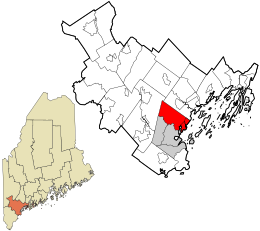Falmouth, Maine
| Falmouth, Maine | ||
|---|---|---|
| Town | ||

Casco Bay in 1910
|
||
|
||
 Location in Cumberland County and the state of Maine. |
||
| Coordinates: 43°43′46″N 70°14′31″W / 43.72944°N 70.24194°W | ||
| Country | United States | |
| State | Maine | |
| County | Cumberland | |
| Incorporated | November 12, 1718 | |
| Area | ||
| • Total | 36.34 sq mi (94.12 km2) | |
| • Land | 29.38 sq mi (76.09 km2) | |
| • Water | 6.96 sq mi (18.03 km2) | |
| Elevation | 102 ft (31 m) | |
| Population (2010) | ||
| • Total | 11,185 | |
| • Estimate (2012) | 11,399 | |
| • Density | 380.7/sq mi (147.0/km2) | |
| Time zone | Eastern (EST) (UTC-5) | |
| • Summer (DST) | EDT (UTC-4) | |
| ZIP code | 04105 | |
| Area code(s) | 207 | |
| FIPS code | 23-24495 | |
| GNIS feature ID | 0582472 | |
| Website | www |
|
Falmouth is a town in Cumberland County, Maine, United States. The population was 11,185 at the 2010 census. It is part of the Portland–South Portland–Biddeford, Maine metropolitan statistical area.
This northern suburb of Portland borders Casco Bay and offers one of the largest anchorages in Maine. The town is home to three private golf clubs and the Portland Yacht Club.
Native Americans followed receding glaciers into Maine around 11,000 BCE. At the time of European contact in the sixteenth century, Algonquian speaking people inhabited present-day Falmouth. These people spoke the Eastern dialect of the Wabanaki language. Captain John Smith observed a semi-autonomous band known as the Aucocisco inhabiting Casco Bay. English explorer Christopher Levett met with the Aucocisco Sagamore Skittery Gusset at his summer village at the Presumpscot Falls in 1623.
A combination of warfare and disease decimated Native peoples in the years before English colonization, creating a "shatter zone" of devastation and political instability in what would become southern Maine. The introduction of European wares in the 1500s reoriented long-standing Native trade relationships in the Gulf of Maine. Warfare soon broke out among groups such as the Mi'kmaq and Penobscot who sought to subjugate their neighbors by monopolizing access to European goods. The arrival of foreign pathogens only served to compound the upheaval in the region. A particularly notorious pandemic between 1614 and 1620 ravaged the population of coastal New England with mortality rates at upwards of 90 percent. Native peoples were not totally destroyed however, maintaining a presence in the Casco Bay area until King George's War in the 1740s. French military defeat and increasing English settler migration to the area from primarily southern New England impelled most Native Americans to migrate toward the protection of New France or further up the coast where they remain today.
...
Wikipedia

